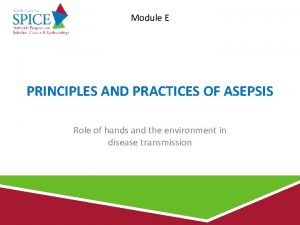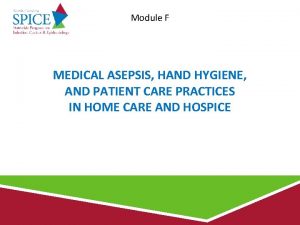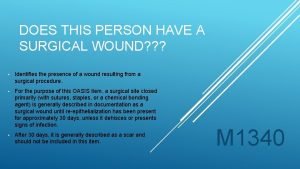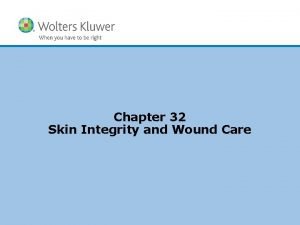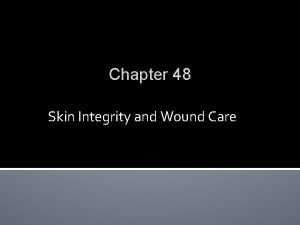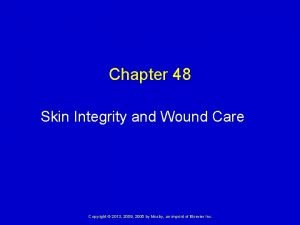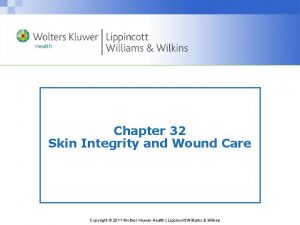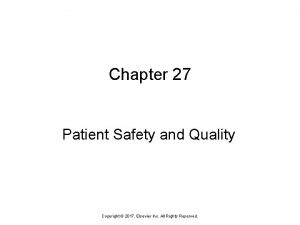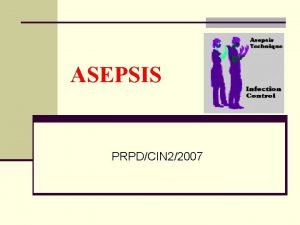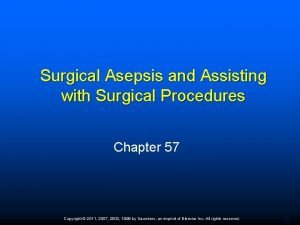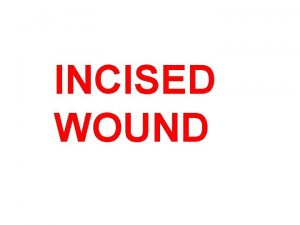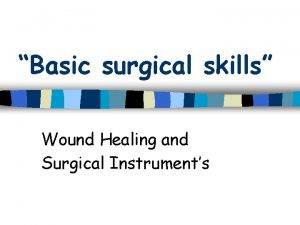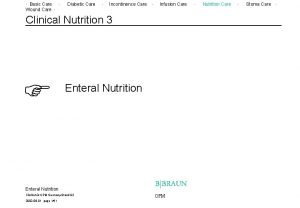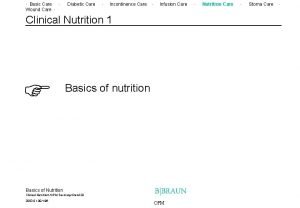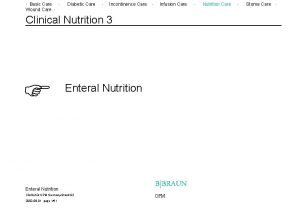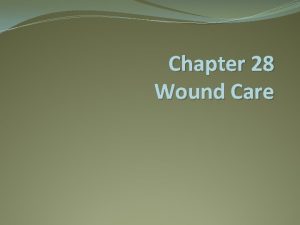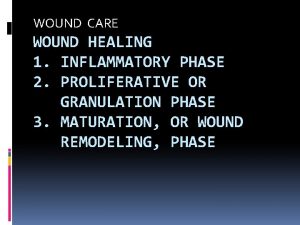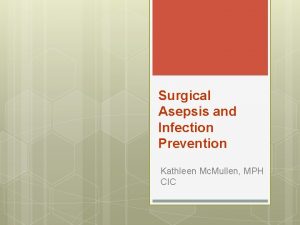Surgical Asepsis and Wound Care Fundamentals Unit 8






















- Slides: 22

Surgical Asepsis and Wound Care Fundamentals Unit 8

Surgical Asepsis and Wound Care n Terms n n n Preoperative Intraoperative Postoperative Skin prep Shave prep What is surgical asepsis? n n n Free from all microorganisms Only as good as the most careful person If sterility is doubt, consider contaminated!

Surgical Asepsis and Wound Care n n n Pathogen evolution and antibiotic resistance Sterile technique is used for… Use sterile technique when entering sterile interior of the body n n n Bladder Wounds Veins Lower airways Rules for sterile technique…

Surgical Asepsis and Wound Care n The surgical scrub… n n n n The stroke method The timed method Up the arm to 2 inches above elbow Keep hands above the elbows Rinse in one direction only, fingers first Dry each hand with a separate sterile towel Sterile gloving Let’s do it!

Surgical Asepsis and Wound Care n The 3 types of wound healing are… n n n First intention – skin edges close together Second intention – adhesion of two granulated surfaces Third intention – left open and closed later

Surgical Asepsis and Wound Care n Factors which affect wound healing… n n n Age Nutrition Metabolism Medication Edema Foreign bodies Radiation Dressing technique Drains Stressors Closures

Surgical Asepsis and Wound Care n n n Purposes for a dressing… Purposes for leaving wounds open to air… Some dressing change guidelines are… Removing the dressing Some safety factors in wound care

Surgical Asepsis and Wound Care n n n Sterile dressing changes Nursing actions Types of drains n n n Penrose drain Jackson Pratt wound suction Hemovac or Porta-Vac T-tubes Wound VAC

Surgical Asepsis and Wound Care n n How do I care for a patient with a suction device? Discontinuing the drainage device n n n n Check the order! Do with dressing change Relieve the suction! Cut suture prn Pull firmly and place in towel. Inspect! Proceed with dressing change Document

Surgical Asepsis and Wound Care n What are the types of drainage? n n n n Serous Sanguineous Serosanguineous Purulent Mucopurulent Bile Fecal

Surgical Asepsis and Wound Care n Wound infections n n n S and Sx Interventions Wound cultures Dehiscence Evisceration

Surgical Asepsis and Wound Care n n Removal of sutures Removal of staples Wound irrigation Care of the deep wound, with review Let’s practice!

Surgical Asepsis and Wound Care Bandages and Binders n Purposes for bandages and binders are… n n n To apply pressure to control bleeding or edema To immobilize a part To serve as a support To hold splints in place To hold surgical dressings in place

Surgical Asepsis and Wound Care n Types of binders n n Classifications of bandages according to shape n n n Abdominal binder – application may take two people T-binder – suspending bandage Double T-binder – used for the male Triangular – used as a sling Roller – gauze or ace wraps Types of roller bandages n n n Circular Oblique Spiral reverse Figure of eight Recurrent

Surgical Asepsis and Wound Care n Applying bandages n n n n n Position patient Clean part to be bandaged Use pillows prn to elevate Wrap distal to proximal Never let two skin surfaces touch under bandage Never apply a wet or damp bandage tightly Overlap ½ the previous bandage turn width Apply with even tension Note edema present before application Secure the bandage ends

Surgical Asepsis and Wound Care n n Circulatory and neurovascular checks are… Documentation is important n n Type of bandage Area applied to Neurovascular assessments How tolerated

Surgical Asepsis and Wound Care n Removal n n Wash hands, use clean scissors Untape or cut bandage to the side of the wound Unroll bandage, do not allow to fall to floor Special types n n n Mitten Clavicle strap TEDS Now we’ll practice bandaging.

Surgical Asepsis and Wound Care Hot and Cold Applications Terms- Compress Ischemia Maceration Suppuration Tepid Vasodilation Vasoconstriction

Surgical Asepsis and Wound Care n Heat is used for n n n Tissue healing Reduce edema Relieve pain Increases the inflammatory response Cold is used for n n n Prevent edema Control bleeding Relieve pain

Surgical Asepsis and Wound Care Hot and Cold Applications n n n Effects of hot and cold Effects of moist and dry Patients at risk for hot and cold tx n n n n Children Elderly Unconsciousness Peripheral vascular disease Damage to the nervous system Broken areas of skin Fragile areas of skin

Surgical Asepsis and Wound Care n Safety guidelines to follow n n n Equipment Amount of time Adaptation Skin Types of heat applications n n Aquathermia pad Warm, wet compress Whirlpool or soak Sitz bath

Surgical Asepsis and Wound Care n Types of cold applications n n n Ice pack Chemical cold pack Cold, moist compress Tepid sponge bath Temperature ranges Done with unit 8!
 What is medical asepsis
What is medical asepsis Chapter 22 surgical asepsis
Chapter 22 surgical asepsis Medical asepsis hand washing
Medical asepsis hand washing Picc line surgical wound oasis
Picc line surgical wound oasis Serosanguineous vs serous
Serosanguineous vs serous Chapter 48 skin integrity and wound care
Chapter 48 skin integrity and wound care Chapter 48 skin integrity and wound care
Chapter 48 skin integrity and wound care Chapter 48 skin integrity and wound care
Chapter 48 skin integrity and wound care Care of the critically ill surgical patient
Care of the critically ill surgical patient Wound discharge colors
Wound discharge colors Doylestown wound care center
Doylestown wound care center Shasta regional wound center
Shasta regional wound center Torrance memorial cardiac rehab
Torrance memorial cardiac rehab Code of conduct for healthcare support workers
Code of conduct for healthcare support workers Wound care pretest
Wound care pretest Wound care near freedom
Wound care near freedom Biatian
Biatian Primary secondary tertiary health care definition
Primary secondary tertiary health care definition Asepsis and antiseptics
Asepsis and antiseptics A newly admitted patient was found wandering
A newly admitted patient was found wandering Chapter 27 patient safety and quality
Chapter 27 patient safety and quality Fundamentals of care
Fundamentals of care Asepsis antisepsis unterschied
Asepsis antisepsis unterschied
